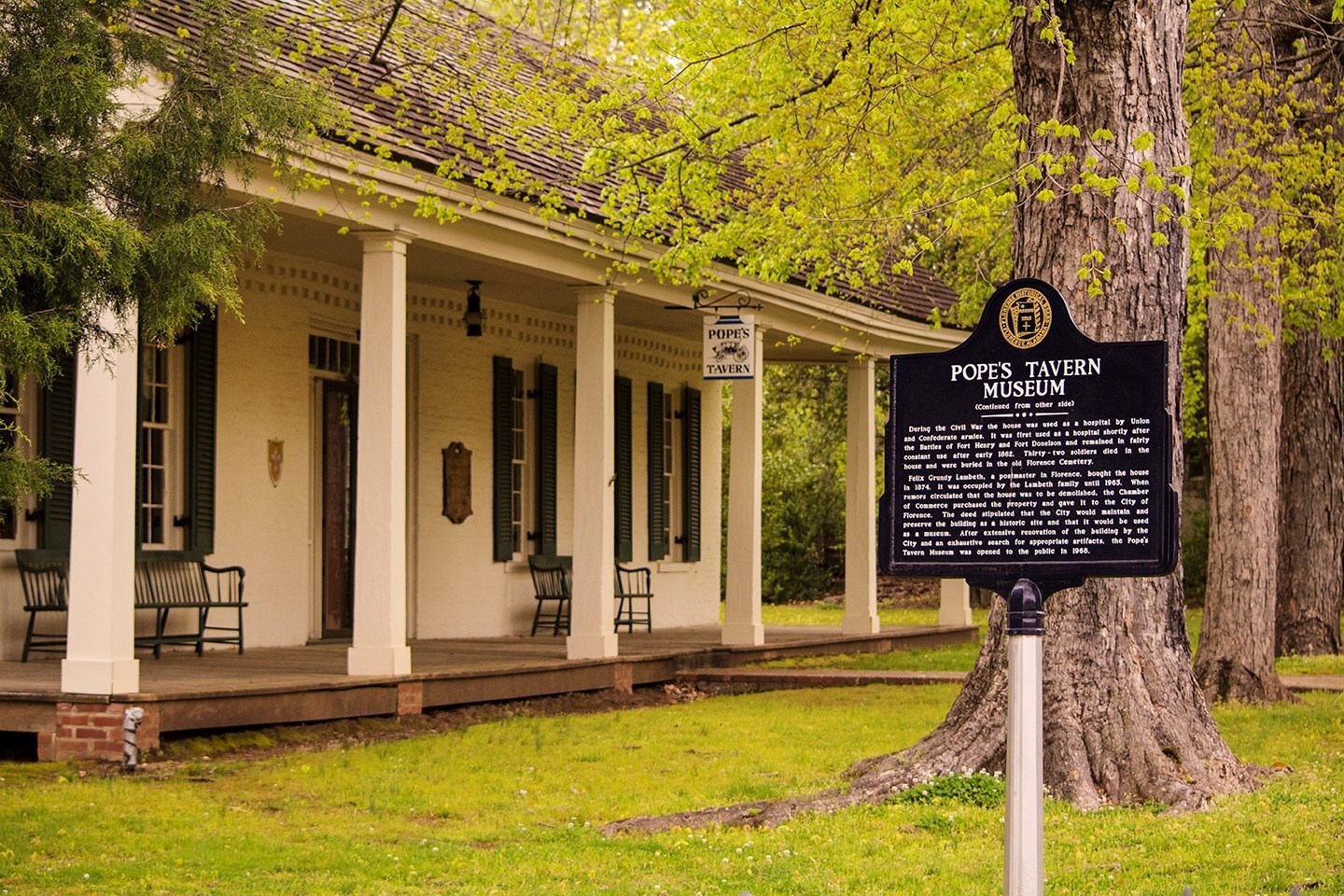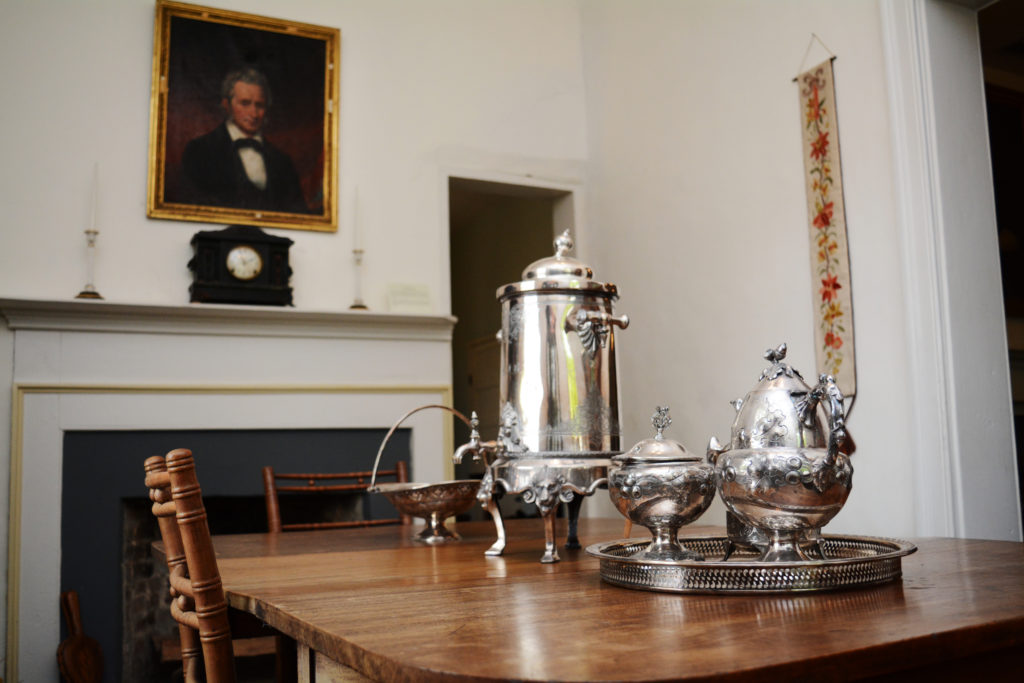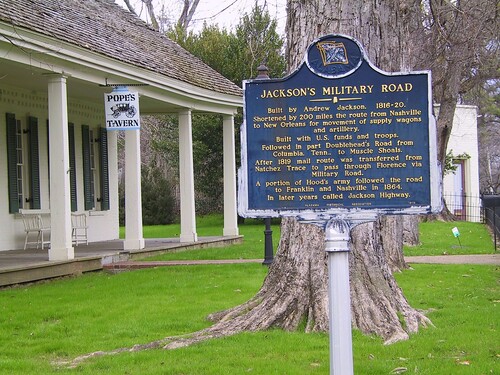Popes Tavern Museum
Popes Tavern Museum is one of the area’s oldest buildings and was once a stagecoach stop as well as a tavern and inn.
However, that is not all, as it also served as a private residence, and during the Civil War, it was also a hospital and command center for both the Southern and Northern armies.
It is located in downtown Florance, in Lauderdale County, and its major goal is to preserve as well as interpret the site of this historic inn and stagecoach stop.
It also has a connection to Andrew Jackson, the famous General during the War, as well as the 7th President of the United States.
Mr. Jackson carved out Military Road personally near the Tavern, as a short cut to move supplies wagons and artillery form Nashville to New Orleans
This famous site has been a major stopping point for travelers dating back to the early of the territorial period, in the early 1800’s.
The History of the Popes Tavern Museum
 The Sign at the Popes Tavern Museum
The Sign at the Popes Tavern MuseumThe history of the Popes Tavern Museum starts with the tradition that a Scottish immigrant by the name of Christopher Cheatham, built the first structure at the site.
This structure turned into an inn as well as a stagecoach stop in the early 1810’s, at the request of several early political leaders in the area.
This would have been a rather tricky endeavor, as the entire region was very lightly populated, and was under the control of both the Cherokees and the Chickasaws.
However, by the year 1817, both of these native American tribes had been forced by the government to turn over most of their land to the United States.
Then, the following year, the Cypress Land Company held their first land sale, in what would later become the city of Florance.
Because of the Military Road built by Andrew Jackson, this young stagecoach stop received a lot of traffic.
Several early settlers were pouring into the area, but archegonial evidence found at the site suggests that the first building at this site burned to the ground.
Then sometime between the 1830’s and 1840’s, construction began on a new building.
It was a one and one-half story, Federal style structure with eight rooms, and made of bricks.
Bricks were used with double-thickness on the outside walls, for one major reason; to keep it cool during the Alabama heat in the summer months.
It was supported by Doric columns to help support it, and numerous homes in the state at the time had the same type of columns on their front porches.
The Civil War and the Popes Tavern Museum
 Silver at the Museum
Silver at the MuseumThe Civil War played a major role in the early history of the Popes Tavern Museum, as the city of Florance changed hands several times between the warring parties.
Although the city did not exepeince a major battle, it was estimated that this young city changed hands over 40 times between the Union and Confederate forces.
Both sides used the local buildings in Florence, including this building, as hospitals to care for their wounded.
The early tradition suggests that numerous soldiers on both sides received treatment at this historic site, until the war ended.
Once the war ended, an attorney named Josiah Patterson purchased he home in 1872, and the in 1974 Felix Lambeth bought it.
It remained in his family until 1965, when the Florance Chamber of Commerce purchased it, and then they donated it to the city.
The Restoration of the Popes Tavern Museum
The city started the restoration of the Popes Tavern Museum shortly after the purchase, and it was finished in 1968.
Once it was completed, the city turned it into a museum, and did additional rehabilitation in both 1988 and 2015.
After this new and completely refurbished facility was completed, the city named it Pope’s Tavern, after Mr. LeRoy Pope.
Mr. Pope was referred to later in life as the “Father of Huntsville”, as he purchased most of the land on which the downtown now stands.
In the year 1811 it was named Huntsville, after pioneer John Hunt.
The Popes Tavern Museum
 Jackson's Military Road Sign
Jackson's Military Road SignThe Popes Tavern Museum today is part of the Florance museum system, which includes four other museums or centers.
They include the W.C. Handy Home and Museum, the Indian Mound and Museum, the Rosenbaum House Museum, as well as the Kennedy-Douglas Center for the Arts.
It is not a heavily trafficked museum, as it has about 2,000 visitors per year.
It is staffed by a curator and two-part time tour guides, and the exhibits there cover a range of subjects.
These subjects include the founding of the city of Florance, as well its role in the Civil War.
The museum also has the following artifacts that include the following.
- A Rare Kennedy Long Rifle
- A Confederate Colonels’ Uniform
- Civil War Weapons and Ammunition
- Civil War Flags
The Civil war flag was carried by Charles Stewart, who was with the Fourth Alabama Infantry Regiment, and was at the Battle of Bull Run.
Bull Run was the first major battle and fighting of the Civil war, and it occurred on July 21, 1861.
In 2021, a team of archaeologists from the University of Alabama, uncovered additional artifacts that are still being studied.
The programs at the museum include historical talks and films, as well as workshops centered on the early history of the area and town.
In October of 2021, a new permanent exhibit was opened, called “Slavery and Cotton in the Shoals”.
If you and your family are in or visiting the area, this makes a great day trip, to learn about the Civil War and the impact it had in this area.
References
http://encyclopediaofalabama.org/article/h-3669

Alabama Gift Store
Numerous Items for You and Your Family to Enjoy
See it here at the Gift Store
Copyright 2019-2023 Alabamabackroads.com
All Rights Reserved
















